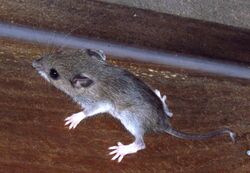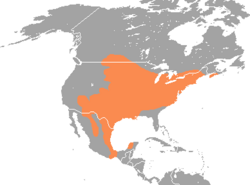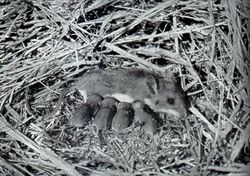Biology:White-footed mouse
| White-footed mouse | |
|---|---|

| |
| Scientific classification | |
| Domain: | Eukaryota |
| Kingdom: | Animalia |
| Phylum: | Chordata |
| Class: | Mammalia |
| Order: | Rodentia |
| Family: | Cricetidae |
| Subfamily: | Neotominae |
| Genus: | Peromyscus |
| Species: | P. leucopus
|
| Binomial name | |
| Peromyscus leucopus (Rafinesque, 1818)
| |

| |
The white-footed mouse (Peromyscus leucopus) is a rodent native to North America from Ontario, Quebec, Labrador, and the Maritime Provinces (excluding the island of Newfoundland) to the southwestern United States and Mexico.[1] In the Maritimes, its only location is a disjunct population in southern Nova Scotia.[2] It is also known as the woodmouse, particularly in Texas.
Description
Adults are 90–100 mm (3.5–3.9 in) in length, not counting the tail, which can add another 63–97 mm (2.5–3.8 in). A young adult weighs 20–30 g (0.7–1.1 oz). While their maximum lifespan is 96 months, the mean life expectancy for the species is 45.5 months for females and 47.5 for males. In northern climates, the average life expectancy is 12–24 months.[3] The species is similar to Peromyscus maniculatus.[4]
Female on a staghorn sumac
Behavior and diet
White-footed mice are omnivorous, and eat seeds and insects. They are particularly voracious predators of the pupal stage of the invasive spongy moth (formerly termed the gypsy moth).[5] They are timid and generally avoid humans, but they occasionally take up residence in ground-floor walls of homes and apartments, where they build nests and store food.[6] White-footed mice spend substantial time in trees and bushes, sometimes taking unoccupied old bird nests and building roofs on them.[7]
Diseases
Like the North American deer mouse, this species may carry hantaviruses, which can cause severe illness in humans. It has also been found to be a competent reservoir for the Lyme disease–causing spirochete, Borrelia burgdorferi.[8] The white-footed mouse is the favored host for the parasitic botfly Cuterebra fontinella.[9]
Interactions with humans
The white-footed mouse is one of the most common mouse species used as laboratory mice after the house mouse, and their domesticated version is called Peromyscus leucopus linville.[10] Such domesticated mice are also kept as pets[11][12] and have been bred to have many different colors.[13]
Adaptations to urbanization in New York City
Native populations of P. leucopus in New York City are isolated by dense human infrastructure and are largely confined to small urban forest islands such as Prospect Park and Central Park.[14] The limited gene flow caused by human activities and coupled with a bottleneck event in urban populations has been powerful enough to lead to evolutionary divergence of urban white-footed mice.[14][15]
Metabolism
New York City mice exhibit local adaptations to diet-mediated selective pressures of urban habitats. Being opportunistic feeders, urban P. leucopus populations subsist on food discarded by humans as a readily available source of nutriment, thereby consuming a lot more fat and carbohydrates than rural populations.[16] Results of a landscape genomics study showed evidence of positive selection in mitochondrial genes of urban mice that are responsible for lipid and carbohydrate breakdown and digestion.[16] Isolated P. leucopus populations inhabiting NYC parks show signs of molecular-level adaptation to urban food resources.[16] The differential evolution of metabolic processes in urban P. leucopus populations is thought to contribute to their success and survival in NYC urban forests.[16] Furthermore, the morphology of urban white-footed mice may be changing to adapt to alternative food sources. For instance, the teeth of white-footed mice in New York City are shorter than the teeth of rural mice.[16] This change in physical traits could be explained by the availability of higher-quality food sources in urban forests, which negates the need for long, powerful teeth.[16]
Detoxification
Urban populations of P. leucopus may be under unique selective pressures due to increased routine exposure to pollutants and toxins. A comparative transcriptome study found evidence of positive selection acting on the genes of urban mice that play major roles in detoxification and xenobiotic metabolism.[17] The genes under positive selection pressure include CYPA1A and Hsp90, which are known to be involved in the metabolism of foreign substances and drugs.[18] High concentrations of heavy metals such as lead and mercury in NYC park soils pose a unique selective pressure that likely led urban populations of P. leucopus to develop metabolic adaptations to the toxicity of urban forest environments.[17] Furthermore, exposure of pollutants is known to induce hypermethylation of DNA.[18] A study showed that in urban white-footed mice, a gene coding for a demethylase enzyme is under positive selection.[18] This means that urban populations of white-footed mice that live in highly polluted environments uniquely benefit from an active demethylase enzyme that removes methyl groups from DNA.[18]
Reproduction
City-dwelling white-footed mouse populations are densely concentrated in isolated urban parks, which makes sperm competition a particularly powerful source of selection in urban environments.[19] Genetic studies have identified signs of molecular-level evolution of reproductive processes in urban white-footed mouse populations. Genes associated with spermatogenesis, sperm locomotion, and sperm-egg interactions in urban mice show a divergent pattern of regulation compared to their rural counterparts.[19] Therefore, the intensified sperm competition of dense mouse populations in urban forests has driven them to develop faster, more efficient sperm than that of rural mice.
Immunity
Urban environments are saturated with large numbers of novel and familiar pathogens that are introduced by transportation, traffic, and trade.[20] The elevated occurrence of pathogens is a driver of directional selection in which genetic variants that more efficiently resist infection are favored. The outcome of this selection can be seen in genetic divergence between urban and rural P. leucopus populations at loci that regulate the innate immune response and inflammation.[21] Furthermore, a study has found evidence of positive selection acting on genes that modulate pathogen recognition in urban mice.[21] Immunoregulatory proteins that are found on T lymphocytes are overexpressed in urban mice when compared to rural populations.[21] These findings suggest that the immune systems of NYC white-footed mice may be evolving to recognize and respond to pathogens more efficiently. The divergence between rural and urban white-footed mice is especially prominent due to impeded gene flow between these populations, which is caused by landscape barriers including roads, highways, and pedestrian sidewalks.[22] Monitoring the strength of immune defenses in P. leucopus is of special importance because they are commonly infected with dangerous pathogens such as hantaviruses and Borrelia burgdorferi.[22]
See also
References
- ↑ 1.0 1.1 Linzey, A.V.; Matson, J.; Timm, R. (2008). "Peromyscus leucopus". IUCN Red List of Threatened Species 2008. https://www.iucnredlist.org/details/16669/0. Retrieved 5 February 2010.
- ↑ Atlantic Interior, The Natural History of Nova Scotia
- ↑ Mammalian models for research on aging (1981) ISBN:978-0-309-03094-6
- ↑ RR5109-Front Cover-Hantavirus.p65
- ↑ Ostfeld, Richard S. (2023-07-31). "I’m a tick biologist whose body seems to kill off ticks" (in en-US). https://www.statnews.com/2023/07/31/acquired-tick-resistance-illness-vaccine-lyme/.
- ↑ "WHITE-FOOTED AND DEER MICE". http://icwdm.org/handbook/rodents/whitefooteddeermouse.asp.
- ↑ "White-footed Deermouse | Tennessee Wildlife Resources Agency" (in en). https://www.tn.gov/twra/wildlife/mammals/small/white-footed-deermouse.html.
- ↑ "Reservoir competence of white-footed mice for Lyme disease spirochetes". The American Journal of Tropical Medicine and Hygiene 36 (1): 92–6. January 1987. doi:10.4269/ajtmh.1987.36.92. PMID 3812887.
- ↑ "Cuterebra fontinella parasitism on Peromyscus leucopus and Ochrotomys nuttalli.". Southeastern Naturalist 5 (1): 157–168. 2006. doi:10.1656/1528-7092(2006)5[157:CFPOPL2.0.CO;2].
- ↑ "Peromyscus leucopus mice: a potential animal model for haematological studies". International Journal of Experimental Pathology 95 (5): 342–50. 2014. doi:10.1111/iep.12091. PMID 25116892.
- ↑ "White-Footed & Deer Mice Care Sheet by Ann Vole". http://mouseranch.com/careSheets/whiteFooted&DeerMice.shtml.
- ↑ Clive Roots; Domestication - page: 105
- ↑ "Deer Mice and White-footed Mice". 2010-06-03. https://retrieverman.net/2010/06/03/deer-mice-and-white-footed-mice/.
- ↑ 14.0 14.1 Harris, Stephen E.; Xue, Alexander T.; Alvarado-Serrano, Diego; Boehm, Joel T.; Joseph, Tyler; Hickerson, Michael J.; Munshi-South, Jason (2016-04-01). "Urbanization shapes the demographic history of a native rodent (the white-footed mouse, Peromyscus leucopus ) in New York City" (in en). Biology Letters 12 (4): 20150983. doi:10.1098/rsbl.2015.0983. ISSN 1744-9561. PMID 27072402.
- ↑ Harris, Stephen E.; Munshi‐South, Jason (2017-10-05). "Signatures of positive selection and local adaptation to urbanization in white‐footed mice ( Peromyscus leucopus )" (in en). Molecular Ecology 26 (22): 6336–6350. doi:10.1111/mec.14369. ISSN 0962-1083. PMID 28980357.
- ↑ 16.0 16.1 16.2 16.3 16.4 16.5 Harris, Stephen E.; Munshi‐South, Jason (2017-10-05). "Signatures of positive selection and local adaptation to urbanization in white‐footed mice ( Peromyscus leucopus )" (in en). Molecular Ecology 26 (22): 6336–6350. doi:10.1111/mec.14369. ISSN 0962-1083. PMID 28980357.
- ↑ 17.0 17.1 Harris, Stephen E.; Munshi-South, Jason; Obergfell, Craig; O’Neill, Rachel (2013-08-28). Johnson, Norman. ed. "Signatures of Rapid Evolution in Urban and Rural Transcriptomes of White-Footed Mice (Peromyscus leucopus) in the New York Metropolitan Area" (in en). PLOS ONE 8 (8): e74938. doi:10.1371/journal.pone.0074938. ISSN 1932-6203. PMID 24015321.
- ↑ 18.0 18.1 18.2 18.3 Harris, Stephen E.; Munshi‐South, Jason (2017-10-05). "Signatures of positive selection and local adaptation to urbanization in white‐footed mice ( Peromyscus leucopus )" (in en). Molecular Ecology 26 (22): 6336–6350. doi:10.1111/mec.14369. ISSN 0962-1083. PMID 28980357.
- ↑ 19.0 19.1 Harris, Stephen E.; Munshi-South, Jason; Obergfell, Craig; O’Neill, Rachel (2013-08-28). Johnson, Norman. ed. "Signatures of Rapid Evolution in Urban and Rural Transcriptomes of White-Footed Mice (Peromyscus leucopus) in the New York Metropolitan Area" (in en). PLOS ONE 8 (8): e74938. doi:10.1371/journal.pone.0074938. ISSN 1932-6203. PMID 24015321.
- ↑ Bradley, Catherine A.; Altizer, Sonia (2007-02-01). "Urbanization and the ecology of wildlife diseases". Trends in Ecology & Evolution 22 (2): 95–102. doi:10.1016/j.tree.2006.11.001. ISSN 0169-5347. PMID 17113678.
- ↑ 21.0 21.1 21.2 Harris, Stephen (2015-09-30). "Population Genomics of White-Footed Mice (Peromyscus leucopus) in New York City". Dissertations, Theses, and Capstone Projects. https://academicworks.cuny.edu/gc_etds/965.
- ↑ 22.0 22.1 André, A.; Millien, V.; Galan, M.; Ribas, A.; Michaux, J. R. (2017-10-01). "Effects of parasite and historic driven selection on the diversity and structure of a MHC-II gene in a small mammal species (Peromyscus leucopus) undergoing range expansion" (in en). Evolutionary Ecology 31 (5): 785–801. doi:10.1007/s10682-017-9898-z. ISSN 1573-8477. https://doi.org/10.1007/s10682-017-9898-z.
General references
- "Seasonal prevalence of Borrelia burgdorferi in natural populations of white-footed mice, Peromyscus leucopus". Journal of Clinical Microbiology 25 (8): 1564–1566. 1987. doi:10.1128/JCM.25.8.1564-1566.1987. PMID 3624451.
- "Genetic structure of the white-footed mouse in the context of the emergence of Lyme disease in southern Québec". Ecology and Evolution 3 (7): 2075–2088. 2013. doi:10.1002/ece3.620. PMID 23919153.
- "Kinetics of Borrelia burgdorferi dissemination and evolution of disease after intradermal inoculation of mice". The American Journal of Pathology 139 (2): 263–273. 1991. PMID 1867318.
- "Borrelia burgdorferi infection in a natural population of Peromyscus leucopus mice: a longitudinal study in an area where Lyme borreliosis is highly endemic". The Journal of Infectious Diseases 189 (8): 1515–1523. 2004. doi:10.1086/382594. PMID 15073690.
- "Estimating reservoir competence of Borrelia burgdorferi hosts: prevalence and infectivity, sensitivity, and specificity". Journal of Medical Entomology 45 (1): 139–147. 2008. doi:10.1603/0022-2585(2008)45[139:ercobb2.0.co;2]. PMID 18283955.
- "Systemic disease in Peromyscus leucopus associated with Borrelia burgdorferi infection". The American Journal of Tropical Medicine and Hygiene 42 (3): 254–259. 1990. doi:10.4269/ajtmh.1990.42.254. PMID 2316794.
- "Spatiotemporal variation in a Lyme disease host and vector: black-legged ticks on white-footed mice.". Vector-Borne and Zoonotic Diseases 1 (2): 129–138. 2001. doi:10.1089/153036601316977732. PMID 12653143.
- "Longitudinal study of infection with Borrelia burgdorferi in a population of Peromyscus leucopus at a Lyme disease-enzootic site in Maryland". The American Journal of Tropical Medicine and Hygiene 60 (4): 598–609. 1999. doi:10.4269/ajtmh.1999.60.598. PMID 10348235.
- "Tick saliva affects both proliferation and distribution of Borrelia burgdoferi spirochetes in mouse organs an increases transmission of spirochetes by ticks". International Journal of Medical Microbiology 299 (5): 373–380. 2009. doi:10.1016/j.ijmm.2008.10.009. PMID 19147403.
- "Trade-offs within the immune systems of female white-footed mice, Peromyscus leucopus". Functional Ecology 20 (4): 630–636. 2006. doi:10.1111/j.1365-2435.2006.01138.x.
- "Immune defense and reproductive pace of life in Peromyscus mice". Ecology 88 (10): 2516–2528. 2007. doi:10.1890/07-0060.1. PMID 18027755.
- Ostfeld RS, Miller MC & Hazler KR (1996) Causes and consequences of tick (Ixodes scapularis) burdens on white-footed mice (Peromyscus leucopus). J Mammal ; 77:266–273.
- Ostfeld RS, Schauber EM, Canham CD, Keesing F & al. (2001) Effects of acorn production and mouse abundance on abundance and Borrelia burgdorferi infection prevalence of nymphal Ixodes scapularis ticks. Vector Borne Zoonot Dis ; 1:55–63
- Pederson AB, Grieves TJ (2008) 'he interaction of parasites and resource cause crashes in wild mouse population. J Anim Ecol ; 77:370–377
- Schwan, TG, Burgdorfer, W, Schrumpf, ME, Karstens, RH. (1988) The urinary bladder, a consistent source of Borrelia burgdorferi in experimentally infected white-footed mice (Peromyscus leucopus). J Clin Microbiol ; 26:893–895
- "Antibody response in white-footed mice (Peromyscus leucopus) experimental infected with the Lyme disease spirochete (Borrelia burgdorferi)". Infection and Immunity 57 (11): 3445–3451. 1989. doi:10.1128/IAI.57.11.3445-3451.1989. PMID 2807530.
- "Borrelia burgdorferi has minimal impact on the Lyme disease reservoir host Peromyscus leucopus". Vector-Borne and Zoonotic Diseases 11 (2): 117–124. 2011. doi:10.1089/vbz.2009.0215. PMID 20569016. http://gbif.ch/files/content/sites/labpar/files/shared/publicationsMV/Schwanz_Voordouw_al_2011.pdf. Retrieved 2014-04-24.
External links
- White-footed Mouse, State University of New York, College of Environmental Science and Forestry
- White-footed Mouse, CanadianFauna.com
- White-footed Mouse, Canadian Biodiversity Website
 "Deer-mouse". Encyclopedia Americana. 1920.
"Deer-mouse". Encyclopedia Americana. 1920.
Wikidata ☰ Q732863 entry
 |






